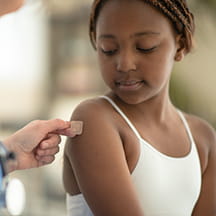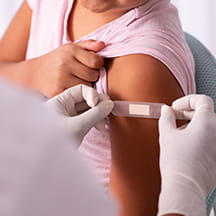Though their child wasn’t receiving medical treatment at the time, that one day at Nationwide Children’s Hospital changed the family’s life forever.
The parents hadn’t filed income tax returns for three years, but they followed a referral from a Nationwide Children’s social worker to a free tax-preparation clinic presented by the hospital. An hour later, the family walked away with $35,000 in tax credits—an amount equal to their entire annual household income. “They were obviously through-the-roof excited,” says Nick Jones, vice president of community wellness at Nationwide Children’s in Columbus, Ohio. “It’s those types of stories that convince us this is the right thing to do.”
Many children’s hospitals and health systems are seeing an opportunity to improve health outcomes by supporting families who are facing challenging financial situations, especially as the cost of health care continues to rise. While lower income or uninsured families often accumulate health care-related debt, even those with health insurance or a moderate income are not immune to it.
According to a 2022 study from the Kaiser Family Foundation, about half of adults in the U.S. have difficulty affording medical costs. “It’s important to understand what illness, an injury, or a chronic medical condition can do to a family’s financial situation,” says Dawn Walton, chief financial officer at Children’s of Alabama in Birmingham. “It can be devastating. So how can we connect families going through something like that with financial resources?”
To help families make those connections, children’s hospitals are reimagining what supporting families and providing financial assistance looks like. This includes helping families access tax refunds, managing their medical bill payments or facilitating conversations with insurers.
Tax assistance for families
Nationwide Children’s began offering tax-preparation assistance as an effort to help its patient families and some staff members access the Earned Income Tax Credit (EITC). The EITC is available to families below certain annual income thresholds and is a powerful anti-poverty tool—in 2018, it lifted more than 10 million people above the poverty line, including 5.5 million children.
Yet, it’s estimated that 20% of eligible workers don’t claim the credit. And those missed opportunities can have detrimental effects on children’s health. The Centers for Disease Control and Prevention (CDC) has identified EITCs as one of 14 key evidence-based interventions that can improve health. “Strong evidence consistently links low income to adverse childhood experience (ACE) exposures and children’s long-term health, educational and social outcomes,” the agency reports.
Jones sees this program as an immediate opportunity to address the health disparities that result from living in generational poverty. “By lifting these families out of poverty, we can start seeing positive effects on some of those health outcomes,” he says.
The hospital’s pilot program launched five years ago and consisted of a few self-service laptops set up in an old gift shop space where about two dozen families accessed the free tax-preparation software. Today, the initiative has expanded to six fully staffed locations across Columbus, Ohio. In 2022 alone, Nationwide Children’s volunteers helped roughly 520 families claim more than $1.5 million in tax refunds, including about $400,000 in EITC reimbursements.
The hospital’s tax-preparation program has grown exponentially due in large part to three partnerships: Celebrate One, a Columbus-area infant mortality collaborative; Tax Time, the regional United Way’s Volunteer Income Tax Assistance collaborative; and Office of Minority Health at the U.S. Department of Health and Human Services, which provided a grant.
"We want to help those families accomplish all of their hopes, dreams and aspirations."
Teaming up with community organizations enables Nationwide Children’s to reach a broader population, and the hospital is cross-training staffers to ensure they convey a common, consistent message across the groups. Celebrate One staff and agencies are being trained in referral, outreach and the value of EITC and related tax credits, while Tax Time staff are being trained in ACES, risk and protective factors and community resources for referral.
As such, the tax-preparation service delivers more than tax refunds to families—it’s part of a larger effort: Healthy Neighborhoods Healthy Families (HNHF). Launched in 2008, HNHF is a collaboration among Nationwide Children’s and a variety of community organizations, nonprofit programs and public schools to improve health equity by addressing social determinants of health in the area.
Families seeking assistance through HNHF can access several opportunities related to affordable housing, education, health and wellness, community enrichment and economic development. Jones says the tax-preparation program is a great way to introduce families to other support programs available in their community.
“We’re trying to make an easy-to-access system for families to get into the pipeline of services we have to offer,” Jones says. “We don’t want the tax-preparation experience to be transactional—we certainly want it to help us develop deeper, trusting and long-term relationships that help those families accomplish all of their hopes, dreams and aspirations.”
Erasing medical debt
Children’s of Alabama worked with RIP Medical Debt, a non-profit organization committed to erasing medical debt through donor support, to purchase and erase debt for more than 21,000 families in Alabama.
RIP Medical Debt uses data to pinpoint the medical debt of those most in need: individuals who earn less than four times the federal poverty level, which varies by state and family size, or whose debts are 5% or more of annual income. The organization buys their debt and sends a letter informing them that it has been erased. Families have no tax consequences or penalties to consider. Just like that, they’re free of medical debt.
Children’s of Alabama and RIP Medical Debt first connected in the midst of the COVID-19 pandemic, when the economy was slow, and families were facing more hardships than usual. “We wanted to be a good partner for our patients and our families and a good community partner,” says Walton. “We saw no reason not to do this.”
Children’s of Alabama bills on an encounter-specific basis, which leads to one health episode generating multiple bills. This means that sometimes families on the cusp of the ability to pay for their child’s care may not see the full costs of a care episode until after the fact. “We don’t always readily identify people who need financial assistance because a lot of times they do have insurance,” says Walton. “But they may have deductibles and copays that exceed their ability to pay for it.” This opportunity with RIP Medical Debt allowed the hospital to help support some of those families who may have slipped through the cracks.
RIP Medical Debt managed the entire process between Children’s of Alabama and its patients. In this case, the non-profit had existing donors who wanted to use their funds to eliminate medical debt for families across the state.
After the hospital handed off secure files to RIP Medical Debt, the team identified specific accounts that met the non-profit’s criteria. Then it purchased the debt from the hospital’s third-party debt agency at a discounted rate with money provided by Alabama-based donors.
“We made good on the bad debt and gave the agency what they were due for managing those accounts,” says Walton. Once $29.1 million worth of debt was canceled out, RIP Medical Debt then sent letters to the families letting them know their debt was canceled. “We were happy to do what we could to help our families who really had a need,” says Walton.
Lowering the barrier for assistance programs
In 2019, Gillette Children’s in St. Paul, Minnesota, identified a “lack of financial support and advocacy” as a priority health issue for their organization and the families they serve. While there were existing programs in place to help families, the revenue management team wanted to expand these efforts, making it easier for families to qualify for support and broadening the scope of financial assistance. This led the revenue cycle team down a path of constant evolution to improve the Gillette Assistance Program (GAP), a donor-supported assistance program.
The first thing they did was expand eligibility for the assistance program so more families could qualify—from a household income of 300% of the federal poverty level up to 400% of the poverty level. Then, they continued to dig in and scrutinize their financial assistance efforts to find opportunities for improvement.
The first potential barrier the team discovered was the number of forms and information families must provide to qualify for GAP. Now instead of bank statements, proof of income and a year of financial history, all that’s needed is a W-2 from the prior year. Even then, if a family doesn’t have access to a W-2, the self-pay team will walk through a different application with them. “Because of this, we started to see the applications for the program increase, which was exciting, but we realized there was an influx of questions about insurance we weren’t equipped to answer,” says Ashley Karlen, director of revenue cycle management at Gillette Children’s.
The organizations’ programs didn’t account for the confusion many patients had regarding their billing, insurance and payment requirements. There was an existing financial screening question in place during the new patient and scheduling process to account for any concerns a family may have with their ability to pay. But over time, the team at Gillette Children’s learned that patients and families need specific insight into how their individual insurance plans work with the care they’re receiving and how services that could result in surprise billing might affect their ability to pay.
"We exhaust every possible effort on our end to make sure that something’s going to be covered with the family."
To address this, a new financial advocacy team was created. This is not a team with dedicated work queues, or a call center focused on processing issues as quickly as possible. Instead, the team of advocates is a dedicated resource for parents and families to use when they need support or have financial questions or concerns—whether it’s a three-minute or three-hour conversation.
Additionally, whenever a patient has a scheduled appointment that could result in unplanned costs, an advocate calls to review their insurance plan and walks the family through every scenario so there’s no surprise billing on the back end. Examples of this might be a cranial cap for infants or prosthetic fitting—because insurance plans have started to consider them a “benefit exclusion,” Gillette Children’s billing system prompts the financial advocacy team to reach out and assist the family.
“We’ve learned to start setting up three-way calls with the family and the insurance company because the insurance rep will tell us one thing and the family will tell us another,” says Karlen. “This team is really beneficial and makes sure everybody’s on the same page.”
The advocates do most of the heavy lifting with insurance to reduce the burden on patient families. “We exhaust every possible effort on our end to make sure that something’s going to be covered with the family. We already know these families are dealing with a sick child, with complex medical conditions, and we don’t want insurance to be another stressor for them,” says Karlen. “We are definitely willing to fight that good fight for them.”
Most recently, Gillette Children’s launched a presumptive assistance program. Throughout 2020 and 2021, GAP remained stagnant despite an economic downturn. “There was a population we believed qualified who weren’t applying for GAP and instead were just paying their bills,” says Karlen. “Whether it’s because of stigma around receiving assistance or something else.”
The program uses the guarantor’s information to automatically apply a score for a family prior to them receiving a bill. That score automatically applies a certain percentage of coverage to the bill and proactively applies the discount. Sometimes it’s 25%, sometimes it’s 100%. There are no limits on who can qualify, and the same standards are used in evaluating every family. “We’ve received really positive feedback,” says Karlen. “Some of the families had been on payment plans but never applied for GAP, and now they’re getting assistance. We’re really excited about it and encouraged.”
Karlen says Gillette Children’s ultimate goal with the programs is to remove barriers to care. “We work with teams across the organization, and we are going to find a way for the patient to be seen if we believe they need to be seen at Gillette.” Gillette Children’s effort to reimagine financial assistance follows a broader trend in children’s hospitals expanding their existing programs or reimagining new ones. As health care costs increase, patients and families remain at the center of children’s hospitals and health systems’ effort to improve financial stability and health outcomes.




